Related Research Articles
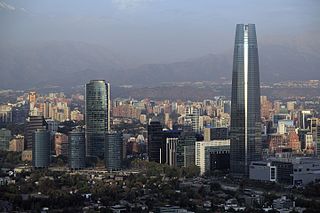
The economy of Chile is a market economy and high-income economy as ranked by the World Bank. The country is considered one of South America's most prosperous nations, leading the region in competitiveness, income per capita, globalization, economic freedom, and low perception of corruption. Although Chile has high economic inequality, as measured by the Gini index, it is close to the regional mean.

Latin America is a collective region of the Americas where Romance languages—languages derived from Latin—are predominantly spoken. The term was coined in France in the mid-19th century to refer to regions in the Americas that were ruled by the Spanish, Portuguese, and French empires.

South America is a continent entirely in the Western Hemisphere and mostly in the Southern Hemisphere, with a considerably smaller portion in the Northern Hemisphere. It can also be described as the southern subregion of the Americas.

The economy of Uruguay features an export-oriented agricultural sector and a well-educated workforce, along with high levels of social spending. Tourism and banking are also prominent sectors; Uruguay acts as a regional hub for international finance and tourism. The country also has a history and representation of advanced workers-rights protection, with unions and the eight-hour work-day protected at the beginning of the 20th century.

The avocado, alligator pear or avocado pear is a medium-sized, evergreen tree in the laurel family (Lauraceae). It is native to the Americas and was first domesticated in Mesoamerica more than 5,000 years ago. Then as now it was prized for its large and unusually oily fruit. The tree likely originated in the highlands bridging south-central Mexico and Guatemala. Its fruit, sometimes also referred to as an alligator pear or avocado pear, is botanically a large berry containing a single large seed. Sequencing of its genome showed that the evolution of avocados was shaped by polyploidy events and that commercial varieties have an hybrid origin. Avocado trees are partly self-pollinating, and are often propagated through grafting to maintain consistent fruit output. Avocados are presently cultivated in the tropical and Mediterranean climates of many countries. Mexico is the world's leading producer of avocados as of 2020, supplying nearly 30% of the global harvest in that year.

Table grapes are grapes intended for consumption while fresh, as opposed to grapes grown for wine production, juice production, or for drying into raisins.

The Southern Hemisphere is the half (hemisphere) of Earth that is south of the Equator. It contains all or parts of five continents and four oceans, as well as New Zealand and most of the Pacific Islands in Oceania. Its surface is 80.9% water, compared with 60.7% water in the Northern Hemisphere, and it contains 32.7% of Earth's land.
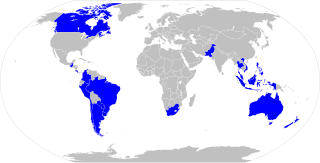
The Cairns Group is an interest group of 19 agricultural exporting countries, composed of Argentina, Australia, Brazil, Canada, Chile, Colombia, Costa Rica, Guatemala, Indonesia, Malaysia, New Zealand, Pakistan, Paraguay, Peru, the Philippines, South Africa, Thailand, Ukraine, Uruguay, and Vietnam.

Citrus production encompasses the production of citrus fruit, which are the highest-value fruit crop in terms of international trade. There are two main markets for citrus fruit:
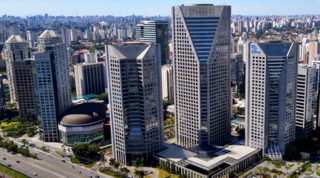
The economy of South America comprises approximately 434 million people living in the 12 sovereign states and three dependent territories of South America, which encompasses 6 percent of the world's population. South America ranks fifth in terms of nominal GDP by continent, behind North America and after Oceania.
The Treaty of Asunción was a treaty between the countries of Argentina, Brazil, Paraguay, and Uruguay signed on March 26, 1991. The objective of the treaty, signed in Asunción, was to establish a common market among the participating countries, popularly called Mercosur. Later, the Treaty of Ouro Preto was signed to supplement the first treaty, establishing that the Treaty of Asunción was to be a legally and internationally recognized organization.
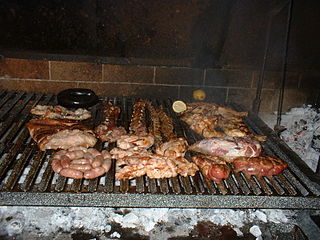
Beef is a key component of traditional Argentine cuisine. In 2019, Argentina was the 4th largest producer of beef, with a production of 3 million tons.

Cripps Pink is a cultivar of apple. It is one of several cultivars sold under the trade mark name Pink Lady. It was originally bred by John Cripps at the Western Australia Department of Agriculture, by crossing the Australian apple Lady Williams with a Golden Delicious; the result is a combination of the firm, long-storing property of Lady Williams with the sweetness and lack of storage scald of Golden Delicious.
According to the World Customs Organization (WCO), an authorized economic operator (AEO) is
"a party involved in the international movement of goods in whatever function that has been approved by or on behalf of a national Customs administration as complying with WCO or equivalent supply chain security standards. Authorized Economic Operators include inter alia manufacturers, importers, exporters, brokers, carriers, consolidators, intermediaries, ports, airports, terminal operators, integrated operators, warehouses and distributors"
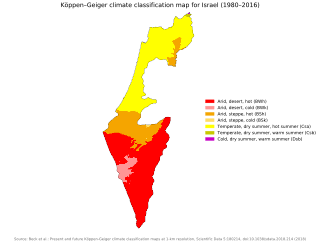
Agriculture in Israel is a highly developed industry. Israel is an exporter of fresh produce and a leader in agricultural technologies. The southern one-half of Israel is desert. The northern one-half is more conducive for agriculture. According to the World Bank, 29.7 percent of Israel is agricultural land. The shortage of water is a constraint. In 2008, agriculture represented 2.5% of total GDP and 3.6% of exports. Israel is not self-sufficient in growing food. In 2021, Israel's agricultural imports totaled 8,791 million and agricultural exports totaled 2,445 million dollars. Grains, oilseeds, meat, coffee, cocoa, and sugar were among the imports.
The World Apple and Pear Association (WAPA) is a trade association established in 2001 representing major apple and pear producing countries globally. The Association provides a forum for member discussion and reviews market information related to fruit trees. In 2007, world apple production reached 66 million tonnes while pear production amounted to 20.5 million tonnes. The secretariat of the association is located in Brussels.

The Southern Common Market, commonly known by Spanish abbreviation Mercosur, and Portuguese Mercosul, is a South American trade bloc established by the Treaty of Asunción in 1991 and Protocol of Ouro Preto in 1994. Its full members are Argentina, Brazil, Paraguay and Uruguay. Venezuela is a full member but has been suspended since 1 December 2016. Associate countries are Bolivia, Chile, Colombia, Ecuador, Guyana, Peru, and Suriname.

Argentina has strong cultural and historical links to the European Union (EU) and the EU is Argentina's biggest investor.
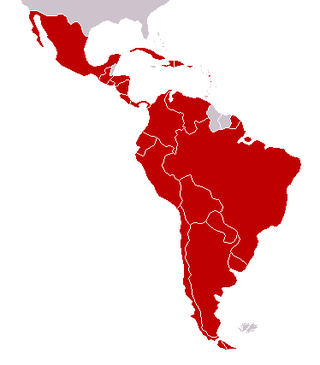
Latin America as a region has multiple nation-states, with varying levels of economic complexity. The Latin American economy is an export-based economy consisting of individual countries in the geographical regions of North America, Central America, South America, and the Caribbean. The socioeconomic patterns of what is now called Latin America were set in the colonial era when the region was controlled by the Spanish and Portuguese empires. Up until independence in the early nineteenth century, colonial Latin American regional economies thrived and worked things out. Many parts of the region had favorable factor endowments of deposits of precious metals, mainly silver, or tropical climatic conditions and locations near coasts that allowed for the development of cane sugar plantations. In the nineteenth century following independence, many economies of Latin America declined. In the late nineteenth century, much of Latin America was integrated into the world economy as an exporter of commodities. Foreign capital investment, construction of infrastructure, such as railroads, growth in the labor sector with immigration from abroad, strengthening of institutions, and expansion of education aided industrial growth and economic expansion. A number of regions have thriving economies, but "poverty and inequality have been deeply rooted in Latin American societies since the early colonial era."
References
- ↑ "Southern Hemisphere citrus shipments increase by almost 2%". 12 April 2012.
- ↑ "Shaffe releases 2012 SH citrus forecast". Archived from the original on 2013-01-24. Retrieved 2012-06-27.
- ↑ "Shaffe – Southern Hemisphere Association of Fresh Fruit Exporters". August 3, 2022.
- ↑ SHAFFE Proposal for realistic harmonization